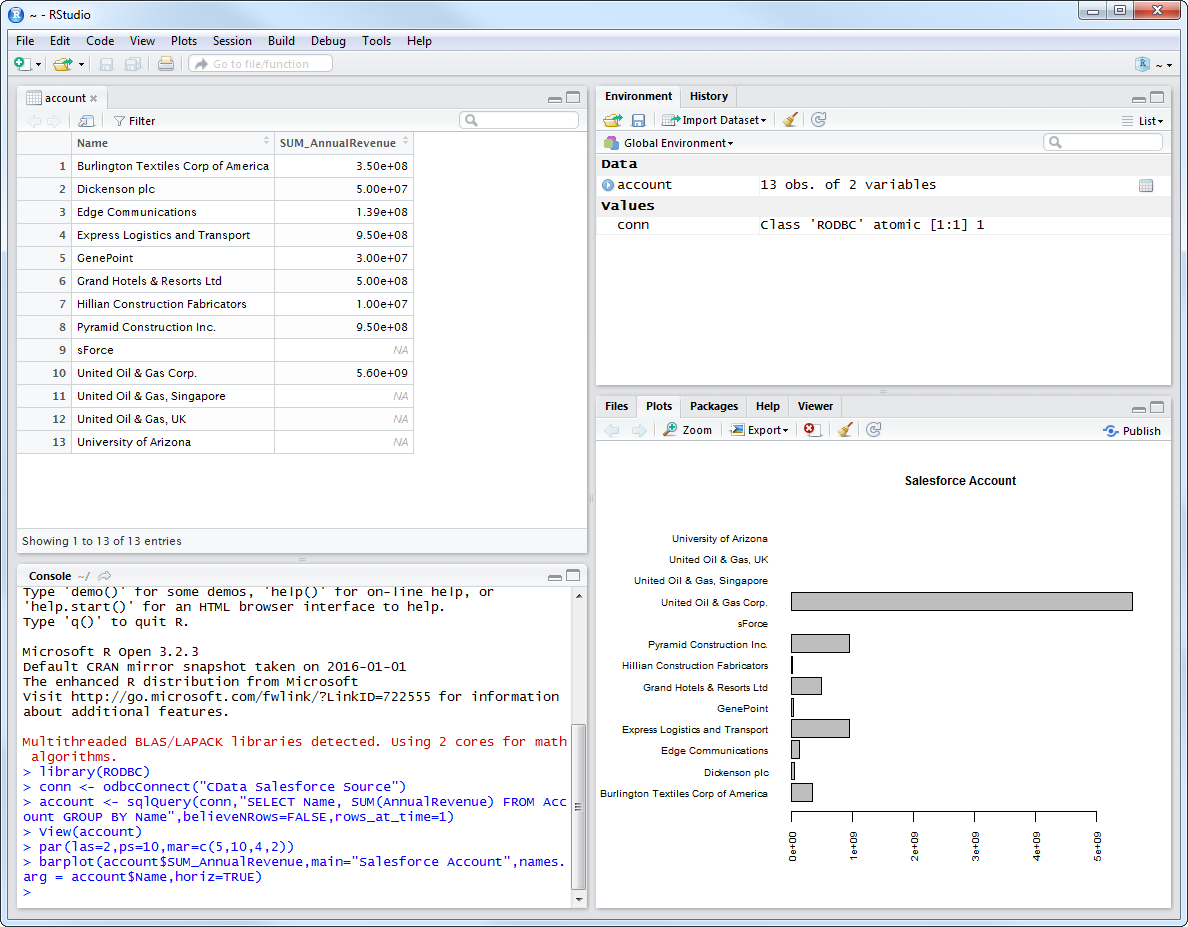Discover how a bimodal integration strategy can address the major data management challenges facing your organization today.
Get the Report →Analyze Adobe Analytics Data in R
Create data visualizations and use high-performance statistical functions to analyze Adobe Analytics data in Microsoft R Open.
Access Adobe Analytics data with pure R script and standard SQL. You can use the CData ODBC Driver for Adobe Analytics and the RODBC package to work with remote Adobe Analytics data in R. By using the CData Driver, you are leveraging a driver written for industry-proven standards to access your data in the popular, open-source R language. This article shows how to use the driver to execute SQL queries to Adobe Analytics data and visualize Adobe Analytics data in R.
Install R
You can complement the driver's performance gains from multi-threading and managed code by running the multithreaded Microsoft R Open or by running R linked with the BLAS/LAPACK libraries. This article uses Microsoft R Open (MRO).
Connect to Adobe Analytics as an ODBC Data Source
Information for connecting to Adobe Analytics follows, along with different instructions for configuring a DSN in Windows and Linux environments.
Adobe Analytics uses the OAuth authentication standard. To authenticate using OAuth, you will need to create an app to obtain the OAuthClientId, OAuthClientSecret, and CallbackURL connection properties. See the "Getting Started" section of the help documentation for a guide.
Retrieving GlobalCompanyId
GlobalCompanyId is a required connection property. If you do not know your Global Company ID, you can find it in the request URL for the users/me endpoint on the Swagger UI. After logging into the Swagger UI Url, expand the users endpoint and then click the GET users/me button. Click the Try it out and Execute buttons. Note your Global Company ID shown in the Request URL immediately preceding the users/me endpoint.
Retrieving Report Suite Id
Report Suite ID (RSID) is also a required connection property. In the Adobe Analytics UI, navigate to Admin -> Report Suites and you will get a list of your report suites along with their identifiers next to the name.
After setting the GlobalCompanyId, RSID and OAuth connection properties, you are ready to connect to Adobe Analytics.
When you configure the DSN, you may also want to set the Max Rows connection property. This will limit the number of rows returned, which is especially helpful for improving performance when designing reports and visualizations.
Windows
If you have not already, first specify connection properties in an ODBC DSN (data source name). This is the last step of the driver installation. You can use the Microsoft ODBC Data Source Administrator to create and configure ODBC DSNs.
Linux
If you are installing the CData ODBC Driver for Adobe Analytics in a Linux environment, the driver installation predefines a system DSN. You can modify the DSN by editing the system data sources file (/etc/odbc.ini) and defining the required connection properties.
/etc/odbc.ini
[CData AdobeAnalytics Source]
Driver = CData ODBC Driver for Adobe Analytics
Description = My Description
GlobalCompanyId = myGlobalCompanyId
RSID = myRSID
OAuthClientId = myOauthClientId
OauthClientSecret = myOAuthClientSecret
CallbackURL = myCallbackURL
For specific information on using these configuration files, please refer to the help documentation (installed and found online).
Load the RODBC Package
To use the driver, download the RODBC package. In RStudio, click Tools -> Install Packages and enter RODBC in the Packages box.
After installing the RODBC package, the following line loads the package:
library(RODBC)
Note: This article uses RODBC version 1.3-12. Using Microsoft R Open, you can test with the same version, using the checkpoint capabilities of Microsoft's MRAN repository. The checkpoint command enables you to install packages from a snapshot of the CRAN repository, hosted on the MRAN repository. The snapshot taken Jan. 1, 2016 contains version 1.3-12.
library(checkpoint)
checkpoint("2016-01-01")
Connect to Adobe Analytics Data as an ODBC Data Source
You can connect to a DSN in R with the following line:
conn <- odbcConnect("CData AdobeAnalytics Source")
Schema Discovery
The driver models Adobe Analytics APIs as relational tables, views, and stored procedures. Use the following line to retrieve the list of tables:
sqlTables(conn)
Execute SQL Queries
Use the sqlQuery function to execute any SQL query supported by the Adobe Analytics API.
adsreport <- sqlQuery(conn, "SELECT Page, PageViews FROM AdsReport WHERE City = 'Chapel Hill'", believeNRows=FALSE, rows_at_time=1)
You can view the results in a data viewer window with the following command:
View(adsreport)
Plot Adobe Analytics Data
You can now analyze Adobe Analytics data with any of the data visualization packages available in the CRAN repository. You can create simple bar plots with the built-in bar plot function:
par(las=2,ps=10,mar=c(5,15,4,2))
barplot(adsreport$PageViews, main="Adobe Analytics AdsReport", names.arg = adsreport$Page, horiz=TRUE)







